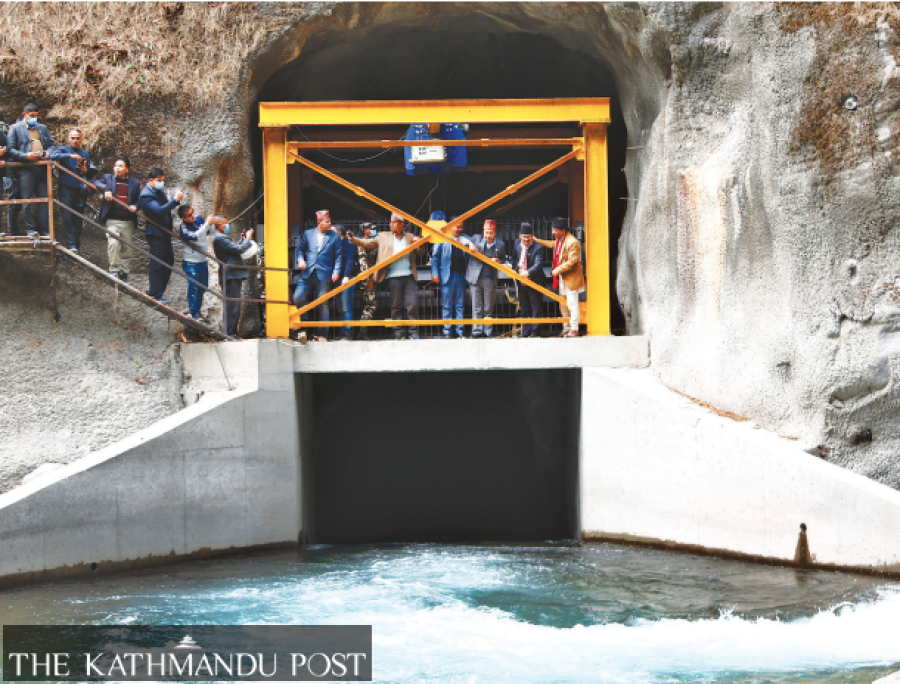Valley
Melamchi water comes to Kathmandu homes, again
Melamchi Water Supply Board is supplying 170 million litres per day under a temporary arrangement even as the headworks remain under flood debris.
Prithvi Man Shrestha
The Kathmandu Upatyaka Khanepani Limited started distributing drinking water supplied by the Melamchi Drinking Water Project, temporarily, to the households of the Kathmandu Valley, starting Friday.
Since the destructive Melamchi flooding in June last year, it is the second time that the water supplied by the project is being distributed to the Kathmandu residents under a temporary arrangement.
As the headworks of the project continue to remain submerged under the debris brought on by a massive flood in June 2021, it is not certain when the water supply can be arranged permanently.
“We started distributing the Melamchi water from three reservoir tanks based in Mahankal, Anamnagar, and Minbhawan,” said Prakash Kumar Rai, spokesperson at the Kathmandu Upatyaka Khanepani Limited (KUKL), which is responsible for distributing Melamchi’s water in the Valley.
“Water has been distributed in New Road, some parts of Chhetrapati, Tripureshwar, New Baneshwar, Mahankal, parts of Chabahil and Kapan area on Friday.”
Rai said the process of filling up the other seven reservoir tanks is underway. “It may take around a week to distribute Melamchi’s water in all the areas of the Valley,” he added.
Malamchi’s water is mostly being distributed through the older piped distribution system. The KUKL plans to distribute Melamchi’s water on alternate days in the Kathmandu Valley, after publishing a schedule.
Before the KUKL started distributing the water in the Valley, the Melamchi Water Supply Development Board had diverted Melamchi’s water to a Sundarijal-based water treatment plant a week ago.
“After cleaning up the Melamchi stream and a little renovation, the water was brought to Sundarijal by creating temporary diversion infrastructure,” said Rajendra Pant, spokesperson at the Melamchi Water Supply Development Board. “We did it to ease the water crisis in the Valley, although the headworks continue to remain submerged under the debris brought by the massive floods in 2021.”
The devastating Melamchi flooding, attributed to a sudden bursting of the river blocked by landslides triggered by incessant rainfall, had caused significant damage to the Melamchi Water Supply Project.
Not only the infrastructure, the flooding also resulted in the loss of lives and several individuals associated with the project and many locals still remain missing.
The headworks of the project got submerged in 20-24 metres of the debris, but the tunnel remained safe as it was closed, according to the Ministry of Water Supply.
When the tragedy befell, the project had just commenced delivering water to the households in Kathmandu after a long delay. In March 2021, water from the Melamchi river in Sindhupalchok district finally made it to Kathmandu after decades-long wait and after missing countless deadlines.
But the jubilation was short-lived with a catastrophic flooding causing significant damage to the project whose construction was almost complete. In January this year, the government approved the variation order of Rs360 million for cleaning up the Melamchi stream to temporarily deliver water to the residents in Kathmandu.
The Chinese contractor—SinoHydro was assigned the task. After initial success, the Melamchi Water Supply Development Board resumed supplying water for Kathmandu in late April when the water shortage usually worsens in the Valley.
But along with the advent of the monsoon season in June, the project discontinued supplying Melamchi’s water to Kathmandu, citing a risk to the project’s structure from potential flooding, once again. Six months after the discontinuation of the water supply to Kathmandu, the Melamchi Water Supply Board has once again started supplying the water.
Pant said that water is being supplied as per the capacity of the project’s first phase. Under the first phase of the project, 170 million litres per day is supposed to be supplied to the Valley from the Melamchi River in Sindhupalchok.
In the second phase, the project is estimated to fetch 170 million litres of water each from Yangri and Larke rivers, supplying 510 million litres of water daily to Kathmandu Valley.
“The people in the Valley will not have to suffer from the water crisis this winter, like before,” said Pant. According to him, a permanent solution will be explored after the Asian Development Bank, which is studying damages to the headworks and is exploring ways of constructing a permanent structure of headworks, submits its report by the end of December. This means it will take more time to complete the long-delayed project.
Earlier, the national pride project was embroiled in a controversy and was plagued by several delays over the years. After the Italy-based Cooperativa Muratori e Cementisti di Ravenna (CMC) abandoned the project in December 2018 over a financial dispute with the government, a Chinese contractor was hired in September 2019 for completing the remaining works.
Then the Covid-19 pandemic struck and hit its progress. At the time, the much-awaited project was on course to meet its fresh deadline of mid-July, 2020 for supplying water to Kathmandu.
Even after the completion of the first phase of the project, the supplied water would not be adequate to fulfil the entire requirement of drinking water in the Kathmandu Valley as the population in the Valley continues to rise.
“There is a demand for 430 million litres of water per day in the Kathmandu Valley, based on the population here,” said Rai. “We will be able to supply more than 280 million litres of water per day after getting 170 million litres of water from the Melamchi project.”




 7.12°C Kathmandu
7.12°C Kathmandu











